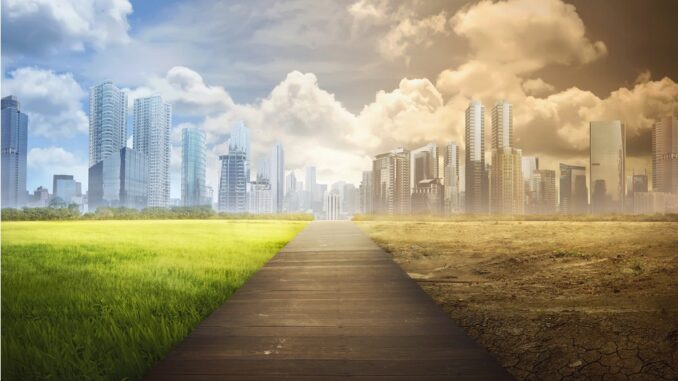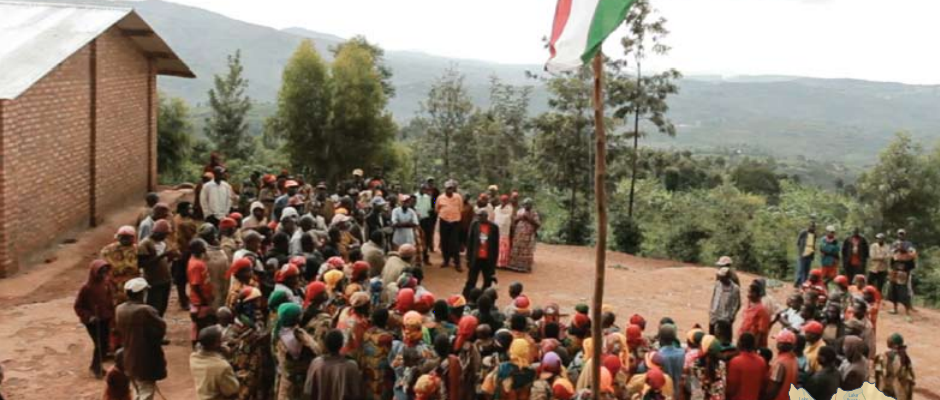
Between 1970 and 2021, the number of people living in cities increased from 1.19 billion to 4.46 billion, while the Earth’s surface temperature climbed by 1.19°C above its preindustrial level. Because of the prosperity they have helped generate, cities have been a major cause of this climate change. It is also in cities, however, that many of the solutions to the climate crisis will be found, not least because by 2050 almost 70 percent of the world’s population will call cities home.
A recent report by the World Bank combines original empirical analysis of a global sample of more than 10,000 cities with insights from secondary literature to take stock of how green, how resilient, and how inclusive cities are today, and to examine the two-way interplay between cities and climate change. Informed by this analysis, the report provides a compass for policy makers on how to help their cities become greener, more resilient, and more inclusive—in other words, on how to help their cities thrive—in a changing climate.
A changing climate
Climate change is exposing cities to increasingly frequent extreme weather events. From the 1970s to the period 2010–20, the frequency of extreme heat and dry events increased across cities globally, and the frequency of extreme wet events has increased since the 1990s. Global sea-level rise of about 0.125 millimeters per year is also increasing the risk of flooding for coastal cities.
How green, how resilient, and how inclusive are cities?
Cities in high- and upper-middle-income countries are major contributors to climate change, whereas the contribution of cities in lower-income countries is modest. Globally, about 70 percent of anthropogenic greenhouse gas emissions, the bulk of which are fossil carbon dioxide (CO2) emissions, emanate from cities. Cities in lower-income countries, however, accounted for only about 14 percent of all global urban CO2 emissions in 2015, and cities in low-income cities contributed less than 0.20 percent. The mitigation challenge for cities in lower-income countries is to develop without following the historic CO2 emissions trajectories of cities in higher-income countries.
Cities in low- and lower-middle-income countries face the highest exposure to projected climate change–related hazards. Projected exposure for 2030–40 for these cities—based on a composite index that combines projections for six key hazards (floods, heat stress, tropical cyclones, sea-level rise, water stress, and wildfires)—is considerably higher than for cities in higher-income countries.
Cities in low- and lower-middle-income countries are less resilient to increasingly frequent climate change–related shocks and stresses. These cities suffer larger negative impacts to their local levels of economic activity from extreme hot, dry, and wet weather events, as well as from tropical cyclones, than do cities in higher-income countries. The impacts of extreme weather for cities in lower-income countries are particularly pronounced when they reinforce a city’s baseline climatic conditions.
Cities suffer indirect impacts of climate change, especially in low- and lower-middle-income
countries. These indirect impacts occur through a variety of channels. For example, when extreme weather events hit, people in the countryside often seek safe harbor in cities. Extended droughts in rural areas result in faster expansion of urban areas. The resulting new settlements are often informal and established on the outskirts of cities, in urban floodplains with limited access to services.
Construction in countries is gravitating toward cities that will be most affected by climate change. Since the 1960s, construction in countries has increasingly gravitated toward cities projected to become unbearably hot because of climate change—the opposite of what would be expected in the face of intensifying changes in climate.
Lack of inclusiveness contributes to the lack of resilience of cities in low- and lower-middle-income countries. This lack of resilience can be explained, in part, by these cities’ higher rates of poverty and lower levels of access to basic services such as health care and education; water, electricity, and other utilities; solid waste management; digital and financial services; and emergency rescue services.
Cities in low- and middle-income countries are less green in terms of air pollution, and air pollution from key urban sectors presents a greater challenge for larger cities in countries at all income levels. On average, concentrations of PM2.5 (particulate matter of 2.5 microns or less in diameter) in both 2000 and 2015 were lower in cities in high-income countries than in cities in lower-income countries. And a city’s PM2.5 emissions in its residential and transportation sectors—sectors that urban planning and policies can most directly influence—tend to increase with its population.
Policies that improve air quality can help cities both mitigate and adapt to climate change. Many of the activities that contribute to poor urban air quality, such as industrial activities and driving internal combustion engine vehicles, also contribute to global climate change. Consistent with this finding, across cities globally, for the residential and transportation sectors, a strong positive correlation exists between CO2 and PM2.5 emissions.
Cities that develop vertically consume less land, accommodate more people, and are more prosperous. Across cities globally, a doubling of a city’s total height leads to a roughly 16 percent long-run increase in its population and a 19 percent long-run reduction in its land area relative to other cities. These results are accompanied by a 4 percent long-run increase in the intensity of the city’s nighttime lights per capita, which suggests increased prosperity.
Lack of vegetation, especially evident in large cities and cities in upper-middle-income countries, can exacerbate the impacts of extreme heat events in cities. It does so because a lack of vegetation exacerbates the urban heat island effect, which can lead to urban land surface temperatures that are more than 10°C higher than the equivalent rural land surface temperatures.
A policy compass to help cities thrive
A thriving city is one that is green, resilient, and inclusive in the face of a changing climate. The World Bank report presents general conclusions related to the realization of this vision in the form of three questions policy makers should answer: What policy instruments are available? Who wields these instruments? How can policy choices based on these instruments be prioritized and sequenced for effective implementation?
WHAT: Policy options take the form of five I’s: information, incentives, insurance, integration,
and investments. In many instances, the interdependencies between these sets of instruments play out in complementary ways, wherein policies across the bundles strengthen impacts when implemented together.
WHO: Because “traditional” urban stresses interact with climate change–related stresses to determine outcomes, local governments are well-placed to drive climate action. Cities, working with other stakeholders including national governments, the private sector, and civil society, have an important policy wedge at their disposal.
HOW: To ensure their cities thrive, policy makers will need to toggle between, and sandwich together, bundles of policy options drawn from the five I’s. The combination of interventions, their sequencing, and the prioritization of outcomes will vary depending on the characteristics of cities, including their level of risk, level of development, and size.
Read the full report: Mukim, Megha, and Mark Roberts, editors. 2023. Thriving: Making Cities Green, Resilient, and Inclusive in a Changing Climate. Washington, DC: World Bank.



